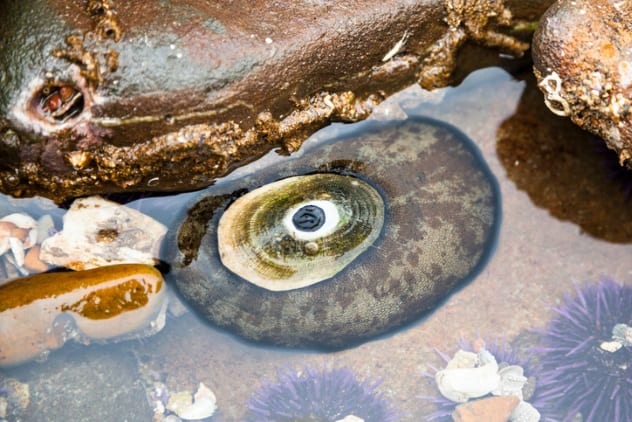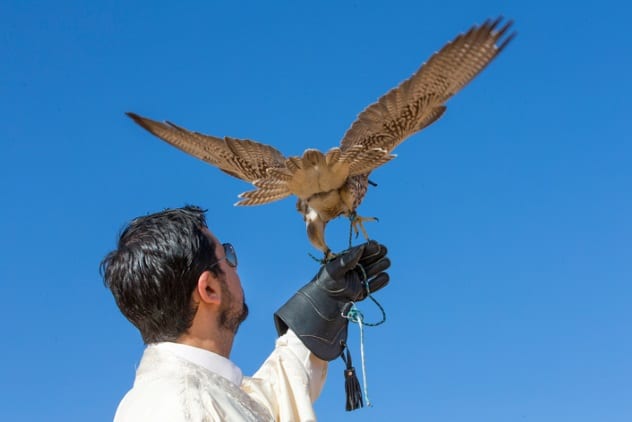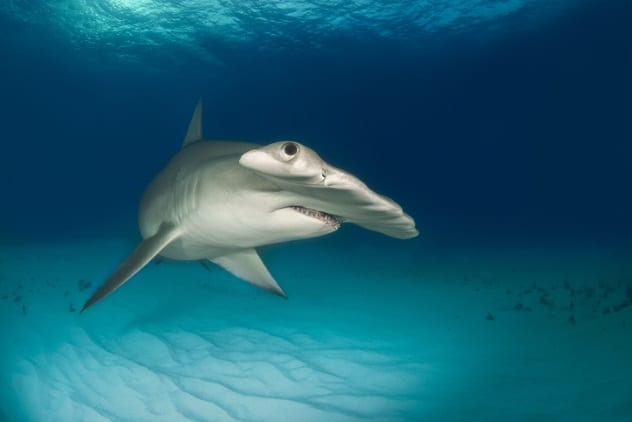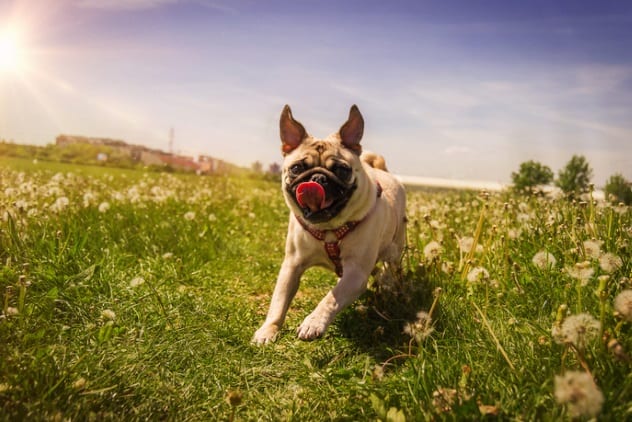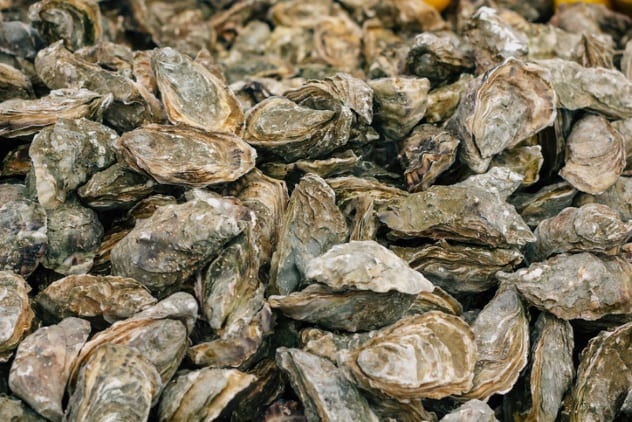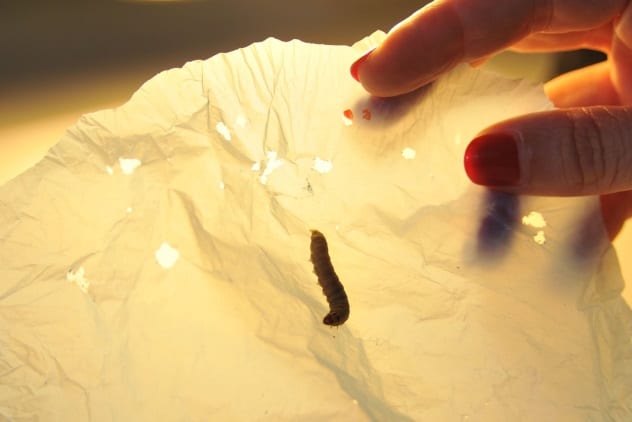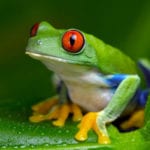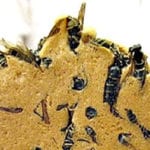Scientists continuously study animals and their unique qualities and find ways to apply those qualities to problems humans face every day. This includes utilizing our most intelligent and trainable animals but also the evolved chemical traits of smaller, lesser-known animals. So, here are ten ways animals help us out that you may never have realized even existed.
10 Keyhole Limpet Proteins
Keyhole limpets are sea snails with, wide, conical shells that feature a small hole at the top, and they have a secret superpower. They contain a protein known as keyhole limpet hemocyanin (KLH), which is used in a wide array of medicines, ranging from cancer and Alzheimer’s medications to vaccinations for animals and humans. The complex structure of hemocyanin makes it a perfect candidate for fighting disease, because it contains many binding sites, which allows other particles bind to it easily.[1] Limpets aren’t the only sea organisms that are used in unexpected ways by humans. For example, kelp is used to create a creamy texture in a myriad of products ranging from ice cream to toothpaste. However, keyhole limpet proteins are used in medications for very serious diseases, and entire companies specialize in the production and sales of KLH. Industries such as this are constantly growing as we find more uses for KLH in medications. Since limpets are invertebrates with no true brain, using them in the medical field has the added bonus of eliminating the question of morality involved when using animals for scientific testing.
9 Cancer-Sniffing Dogs
Dogs will make a few appearances on this list, as they’re so intelligent and easily trained, not to mention adorable. Dogs have about 60 times as many sensory nerves in their noses compared to humans. For years, scientists have known of their ability to sniff out cancer. If you have seen this in headlines, you may think, “Aww, how cute,” and move on. However, there is actually a lot of scientific evidence to back this up.[2] Back in the early 1990s, trained dogs were tested on their ability to smell cancer using various urine samples from patients with and without cancer. The canines could correctly identify samples from cancer patients about 95 percent of the time. Types of cancer they could identify ranged from liver to lung to breast cancer. Although it is unlikely that dogs alone would ever be used to detect cancer in new patients (as much as having dogs around might make the doctor’s office more pleasant), scientist have found a way to implement their olfactory sense into diagnostic machines. They’ve created a device that can “smell” the chemicals being picked up by dogs that are linked to cancerous cells. While this area of study needs more funding before it is viable, the science is all there.
8 Diabetes Dogs
While this topic started out as purely anecdotal and charming stories to make headlines, it has become fact. Cases of dogs predicting low blood sugar in diabetes patients have occurred regularly enough that it became clear they could smell something we could not. Scientists began to look into these cases and studied the exhaled breath of diabetes patients. They discovered that when blood sugar drops to dangerously low levels, the amount of a chemical called isoprene nearly doubles.[3] Humans would never be able to notice such a thing, but the incredible noses of our noble pups can. This is, of course, very impressive and could save even save lives. Dogs are trained to alert owners of this change, giving them time to eat and stabilize their glucose levels to stop themselves from passing out or even having a seizure. These diabetes alert dogs (DADs) are for sale right now. The only downfall? The dogs are hard to train and can cost up to $20,000 to purchase, and this does not even take into account the $1,000 per year it will cost to feed them, on average.
7 Airport Falconry
If you’ve seen the movie Sully, about a pilot whose plane suffers duel engine loss, causing him to perform an emergency water landing on the Hudson River in New York, this entry will sound familiar. The movie was based on a real event, in which birds flew into both engines of a plane soon after takeoff, causing them to break and stopping the plane from flying. You might think there should be a simple way to stop problems like this from occurring. It turns out there is. Trained falcons are used at airports to scare away smaller flocking birds from flying straight into planes during takeoff by using specific warning calls.[4] This is widely practiced in the United States, where damages caused by birds flying into planes can cost more than $500 million per year. If even one engine is ruined, it can cost up to $2 million. Training falcons seems like a small price to pay for flight safety, especially in light of those numbers. Scientists calculate that there is about a one-in-four chance of a bird hitting a plane when falconry isn’t employed. So, next time you fly, be sure to be on the lookout and to thank your bird trainer!
6 Growing Human Organs In Animals
As of January 2017, almost 80,000 people in the US alone were awaiting some kind of organ transplant. It is apparent that not all of these people will find viable organs before it is too late. In lieu of transplantation, scientists have been searching for a way to grow healthy human organs independently. There has been some amount of success, even though the process still has a long way to go before it is commercially available. Scientists have successfully grown human organs inside large animals, such as pigs.[5] Stem cells are taken from the transplant patient’s skin, and because they do not have determined growth, they can still grow into any type of organ or tissue. The main issue facing the medical community is that of morality. In order for the stem cells to grow into a needed organ, the animals must be engineered to develop without that organ so that the body can signal the undetermined cells to generate the required structure. There is currently a ban on using the procedure due to overwhelming complaints over the morality of using animals as vessels for human organ growth.
5 Cancer Immunity In Sharks
For all of us who fear sharks above all else and wish we could go for a swim in the ocean without the threat of shark attacks, just know that they may have genes that could save countless human lives. Recent studies have shown that sharks have an increased immunity to cancer due to their overall highly evolved immune systems. The scariest sharks out there, hammerheads and great whites, are the species which exhibit these extraordinary genes. The genes, known as “legumain” and “Bag1,” are remarkably similar to genes that humans carry. Bag1 plays a role in what is known as apoptosis, or programmed cell death. Programmed cell death is much better than it sounds. The system evolved in order to get rid of defective cells, including cancerous ones. In the case of cancer, this system has broken down or been overwhelmed by mutated cells. Scientists believe Bag1 plays a role in the regulation of apoptosis.[6] Sharks have an amazingly fast healing rate for open wounds as well as a shockingly low infection rate, especially when you factor in the constant contact with various bacteria that live in the ocean. It’ll still be a while before we figure out exactly how they heal so well, but specific genes found in sharks and rays but not bony fish appear to be a factor.
4 Dogs Sniffing For Science
Okay, this is the last dog fact, I promise. Sure, dogs are used to sniff out cancer or diabetes, but their noses can also help us indirectly. Scientists, ever thrifty, have found a low-cost and effective way to weed out invasive plant species: dogs trained to track them down in an effort to keep our nature beautiful and safe.[7] Companies that specialize in this kind of conservational science are currently thriving. Imagine this as your career: spending all day with a lovable dog, training it to find the scent of a particular plant, and then walking out into an open field and letting it roam free until it comes across the scent for you. This is a real job, and I may need to consider a career change. Teams of eight to ten dogs at a time will go out and reveal about two times as many invasive plants as humans can find, just by sniffing. The method is effective, not to mention inexpensive, since the scientists involved don’t need to buy $20,000 dogs. They can often just train their own.
3 Algae Used In Biofuels
Yes, algae aren’t technically animals, but they still have some powerful uses that shock many people. Algae are now being developed as a source of renewable energy. From tiny single-celled organisms to giant kelp, their ability to photosynthesize can help save us from our energy crisis. There are thousands of different types of photosynthetic algae, all with unique properties. Using these organisms as fuel would be as cost-effective as the algae would be cheap to produce.[8] This could be the next step in sustainable, affordable energy. The process is somewhat confusing for those of us not boasting a PhD, but it includes extracting lipids from the algae and subjecting them to high-intensity heat and pressure conditions, a procedure known as hydrothermal liquefaction. This will concentrate the amount of energy created by the algal cells and could ultimately be used in products from jet fuel to gasoline to ethanol. Big oil companies such as ExxonMobil have even been taking notice of the science behind algae. The development of this technology is still underway, but however you feel about big oil, there’s no denying the power of these tiny plants.
2 Oysters Removing Nitrogen
ExxonMobil started a project in 2014 which is planned to take until 2030 to complete and involves adding one billion oysters to the coastal ecosystem in New York. In the past three years since its inception, about 20 million oysters have already been placed. This is clearly a gigantic undertaking, taking up copious time, resources, and workers. However, it does ultimately serve a purpose. Mollusks, including oysters, retain nitrogen in their systems in order to maintain homeostasis. This will allow for a healthier marine ecosystem in surrounding areas, where too much nitrogen may be causing harmful algae to flourish. Marine animals must find ways of dealing with nitrogen if they are to survive. Fish, mollusks, and other marine animals excrete ammonia through urine, which is highly toxic. Oysters, however, will store nitrogen and excrete waste in other forms. Ammonia carries only one nitrogen molecule, whereas releasing uric acid or urea will expel higher levels of nitrogen. In the case of New York Harbor, oysters will essentially pull in water with high nitrogen levels, filter it, and convert the nitrogen into less toxic forms, making the water safer and healthier.[9]
1 Plastic-Devouring Worms
One of the world’s largest pollution problems is plastic. It accumulates all over the planet and is constantly ending up in the ocean. If you walk along a polluted beach, you can find plastic from all over the world, some of which may have traveled thousands of miles from another continent. This problem claims the lives of thousands of sea creatures each year, and humans are always trying to come up with creative and cost-effective ways of reducing plastic use and pollution. Luckily, there is an animal that has already figured out a way to break down our plastic bag problem. The larvae of wax moths, which are often used as bait by fisherman, have the ability to eat plastic without being harmed.[10] Since learning this, scientists have been studying these little worms to determine if they can really have a strong impact on lessening human waste. We know they have the ability to digest plastic, but it is unknown whether or not they can survive and thrive on plastic alone. The worms are also only a few centimeters long, so there would need to be a copious amount of them to make a dent. However, if they do indeed love plastic, they may in the near future be bred to be set loose on human trash.
